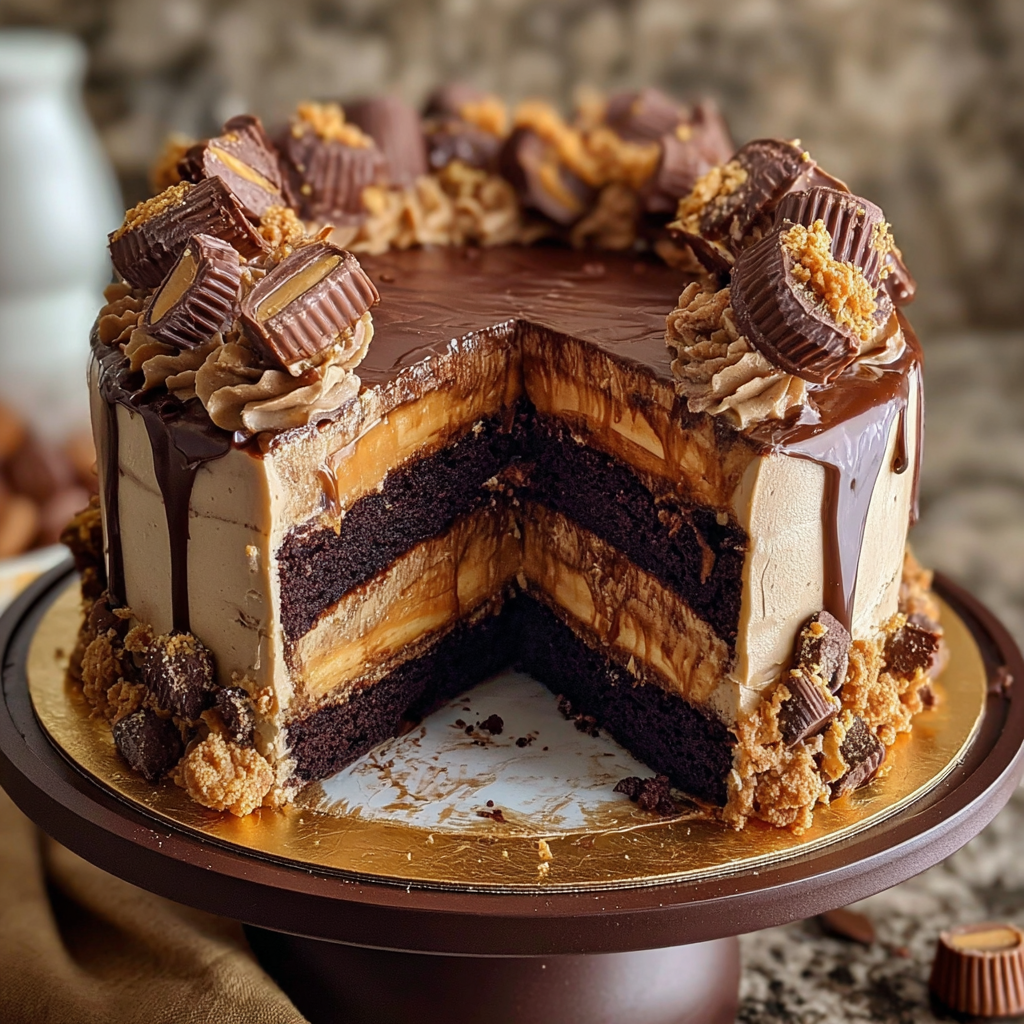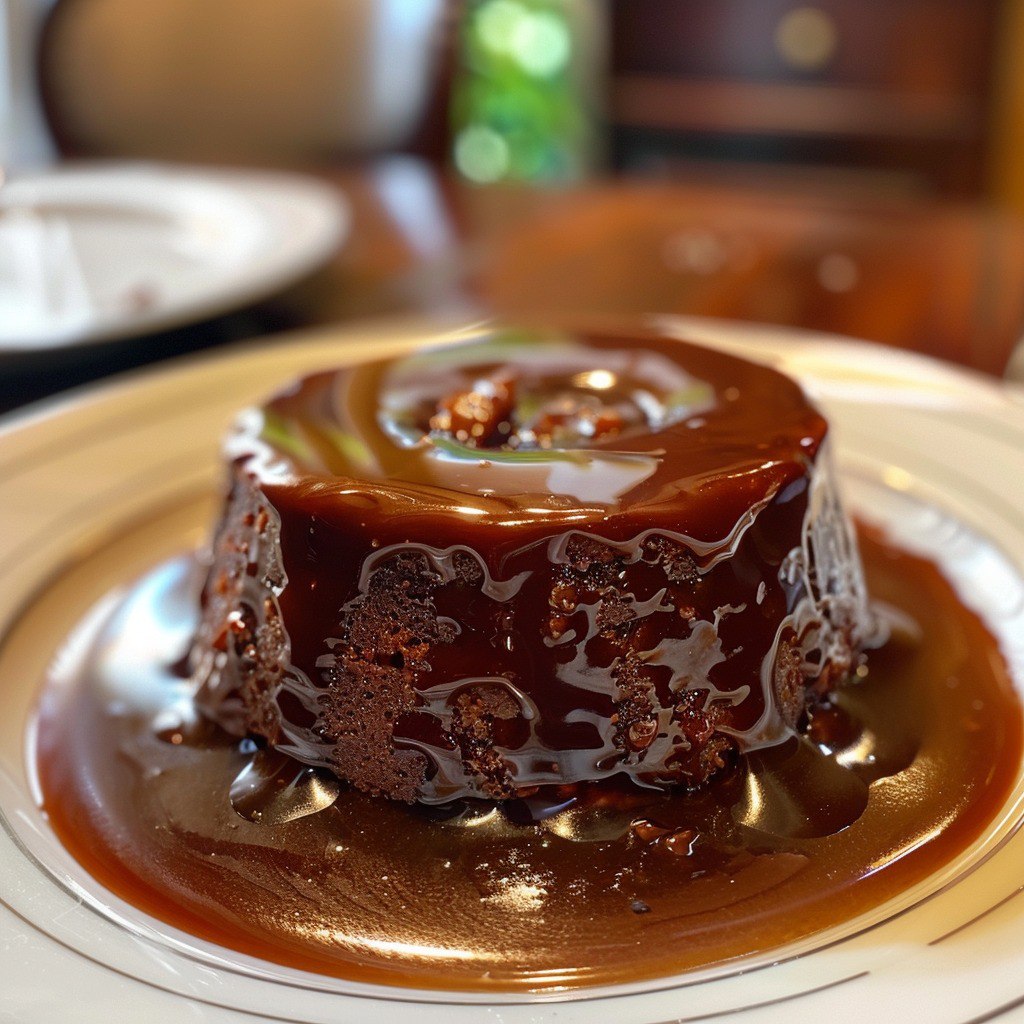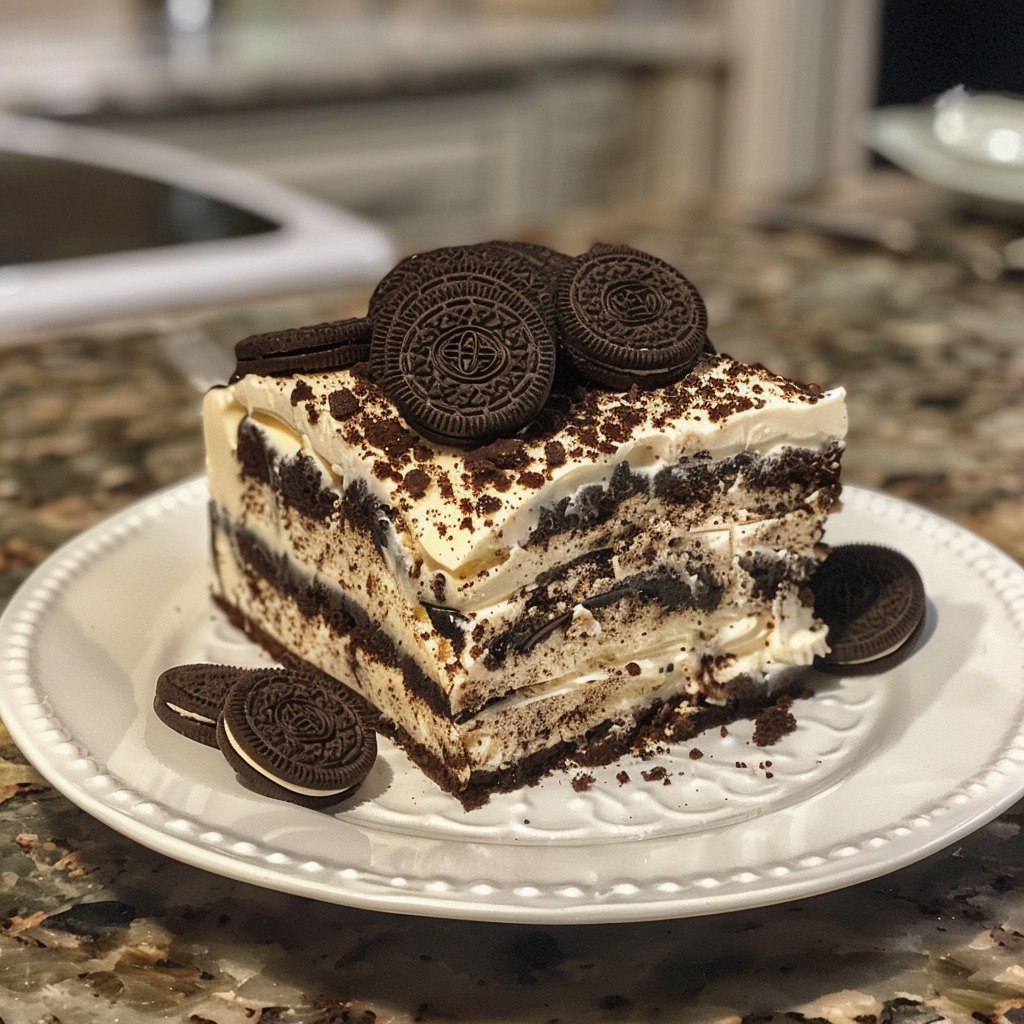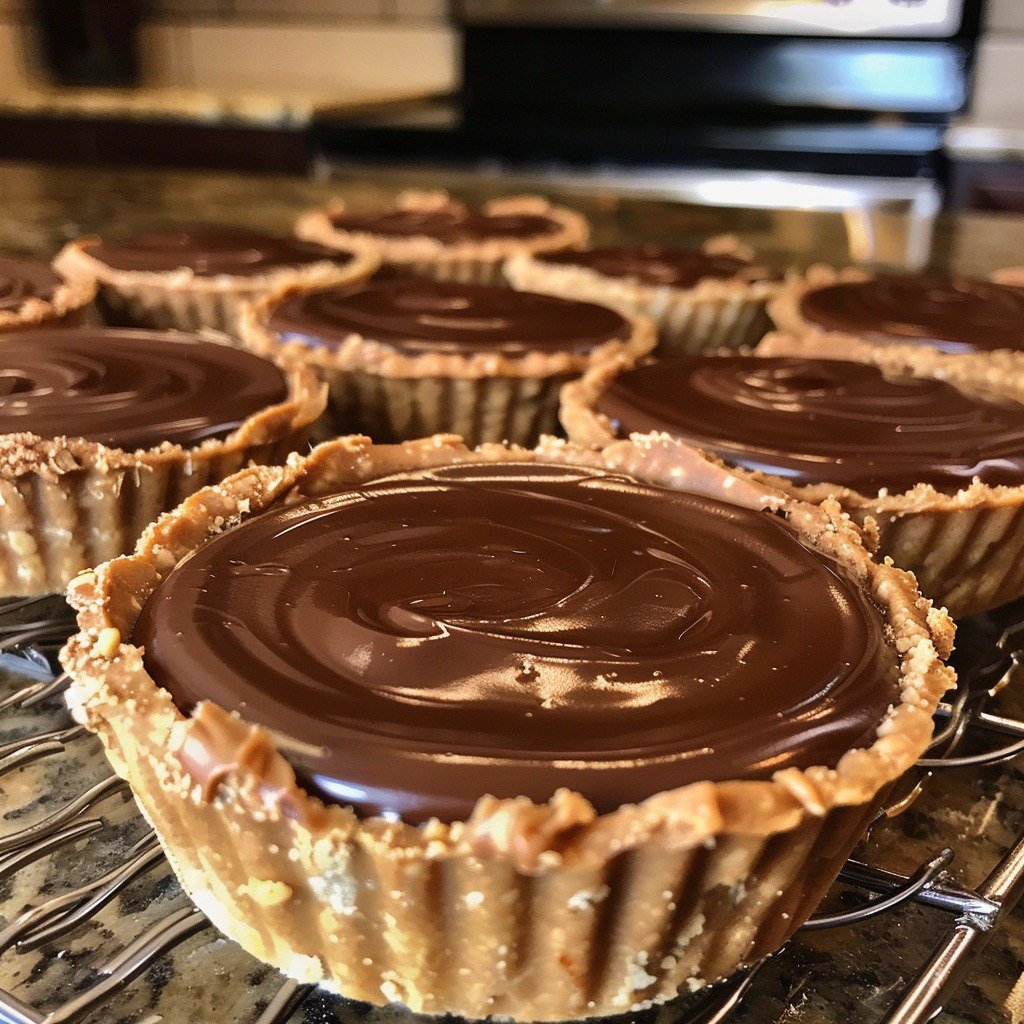Few desserts capture hearts quite like a perfectly crafted German chocolate cake. Moreover, this beloved American classic combines rich chocolate layers with signature coconut-pecan frosting that melts in your mouth. Additionally, despite its name, this cake actually originated in the United States, named after Samuel German’s sweet baking chocolate.
Furthermore, mastering this iconic dessert opens doors to countless celebrations and special occasions. In fact, the combination of moist chocolate cake and creamy coconut-pecan topping creates an unforgettable flavor experience. Therefore, this comprehensive guide will transform you into a German chocolate cake expert, ensuring bakery-quality results every single time.
Print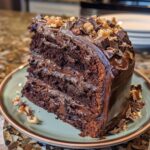
The Ultimate German Chocolate Cake Guide: Master This Classic American Dessert
- Total Time: 1 hr 30 mins
- Yield: Serves 12 1x
- Diet: Vegetarian
Description
This classic German Chocolate Cake features rich, moist chocolate cake layers filled and topped with a luscious coconut-pecan frosting. It’s a show-stopping dessert perfect for birthdays, holidays, or any special celebration. Each bite delivers a perfect harmony of chocolate, coconut, and crunchy pecans.
Ingredients
- For the cake:
- 2 cups all-purpose flour
- 1 cup unsweetened cocoa powder
- 1 1/2 teaspoons baking powder
- 1 1/2 teaspoons baking soda
- 1/2 teaspoon salt
- 2 cups granulated sugar
- 1 cup (2 sticks) unsalted butter, softened
- 4 large eggs
- 1 teaspoon vanilla extract
- 1 cup buttermilk
- 1 cup hot water
- For the coconut-pecan frosting:
- 1 cup evaporated milk
- 1 cup granulated sugar
- 3 large egg yolks
- 1/2 cup (1 stick) unsalted butter
- 1 teaspoon vanilla extract
- 1 1/3 cups sweetened shredded coconut
- 1 cup chopped pecans
Instructions
- Preheat the oven to 350°F (175°C). Grease and flour three 8-inch round cake pans.
- In a large bowl, sift together flour, cocoa powder, baking powder, baking soda, and salt.
- In another bowl, cream together butter and sugar until light and fluffy. Add eggs one at a time, beating well after each addition. Stir in vanilla extract.
- Gradually add the dry ingredients to the creamed mixture, alternating with buttermilk, beginning and ending with the dry mixture. Mix until just combined.
- Stir in hot water until the batter is smooth. Divide the batter evenly between the prepared pans.
- Bake for 25–30 minutes, or until a toothpick inserted in the center comes out clean.
- Cool the cakes in the pans for 10 minutes, then transfer to wire racks to cool completely.
- To make the frosting, combine evaporated milk, sugar, egg yolks, and butter in a medium saucepan. Cook over medium heat, stirring constantly, until thickened, about 10–12 minutes.
- Remove from heat and stir in vanilla extract, coconut, and chopped pecans. Let cool to room temperature.
- Assemble the cake by placing one layer on a serving plate. Spread frosting over the top. Repeat with remaining layers, frosting the top and sides.
Notes
- You can make the cake layers a day in advance and frost the next day.
- Store the cake in an airtight container at room temperature for up to 2 days or refrigerate for longer freshness.
- For a more intense chocolate flavor, add 1/2 teaspoon espresso powder to the batter.
- Use room temperature ingredients for best results.
- Prep Time: 30 mins
- Cook Time: 30 mins
- Category: Dessert
- Method: Baking
- Cuisine: American
Nutrition
- Serving Size: 1 slice
- Calories: 520 kcal
- Sugar: 48 g
- Sodium: 220 mg
- Fat: 28 g
- Saturated Fat: 16 g
- Unsaturated Fat: 10 g
- Trans Fat: 0.5 g
- Carbohydrates: 65 g
- Fiber: 3 g
- Protein: 6 g
- Cholesterol: 95 mg
Keywords: german chocolate cake, coconut pecan frosting, chocolate layer cake, classic chocolate cake, holiday dessert, birthday cake, layered cake
Why You’ll Love This German Chocolate Cake Recipe
This exceptional German chocolate cake stands apart from ordinary chocolate desserts in remarkable ways. Additionally, every element works together to create a harmonious blend of textures and flavors that satisfies even the most discerning palates.
Benefits That Make This Recipe Outstanding
• It’s impressively elegant: Perfect centerpiece for any special celebration • It’s surprisingly achievable: Clear instructions make success accessible to home bakers • It’s authentically traditional: Uses time-tested techniques and classic ingredients • It’s incredibly moist: Buttermilk and hot water create tender, fluffy layers • It’s uniquely flavorful: Coconut-pecan frosting distinguishes it from other chocolate cakes • It’s generously sized: Serves 12 people comfortably for gatherings
Moreover, this recipe produces consistent results that rival professional bakeries. Furthermore, the three-layer construction creates stunning visual impact while ensuring adequate frosting distribution. As a result, every slice delivers the perfect ratio of cake to frosting.
What Makes This German Chocolate Cake Special
Unlike standard chocolate cakes, this version incorporates buttermilk for enhanced tenderness. Additionally, the hot water technique creates an incredibly moist crumb that stays fresh longer. Furthermore, the signature coconut-pecan frosting provides textural contrast that elevates the entire dessert.
Specifically, the cooked frosting develops complex flavors through careful temperature control. Meanwhile, the combination of evaporated milk and egg yolks creates richness without overwhelming sweetness. Therefore, this balanced approach results in sophisticated flavor profiles that appeal to adults and children alike.
Essential Ingredients for Perfect German Chocolate Cake
Creating exceptional German chocolate cake requires understanding each ingredient’s specific role. Moreover, quality ingredients significantly impact the final result, making careful selection worthwhile.
Cake Components That Build Flavor
All-purpose flour provides the essential structure for sturdy yet tender layers. Additionally, unsweetened cocoa powder delivers deep chocolate flavor without excess sweetness. Furthermore, both baking powder and baking soda ensure proper rise and light texture.
Similarly, granulated sugar sweetens while contributing to moisture retention. Meanwhile, unsalted butter creates richness and helps achieve the desired crumb structure. Subsequently, fresh eggs bind ingredients while adding protein for stability.
The buttermilk serves multiple crucial purposes in this recipe. Specifically, its acidity reacts with leavening agents for enhanced lift. Moreover, the tanginess complements chocolate flavors while tenderizing the gluten structure. Therefore, never substitute regular milk, which lacks these essential properties.
Frosting Elements That Create Magic
Evaporated milk forms the creamy base for the distinctive coconut-pecan frosting. Additionally, its concentrated nature provides richness without the water content of regular milk. Furthermore, this ingredient helps achieve the proper consistency for spreading and adhering.
Fresh egg yolks contribute essential richness and help thicken the cooked frosting. Moreover, they create a custard-like texture that coats the coconut and pecans beautifully. However, proper temperature control prevents curdling during the cooking process.
Sweetened shredded coconut adds the signature texture and tropical flavor notes. Meanwhile, chopped pecans provide contrasting crunch and nutty richness. Therefore, use fresh, high-quality nuts for optimal flavor and texture results.
Step-by-Step Guide to Making German Chocolate Cake
Mastering German chocolate cake requires attention to detail and proper technique throughout each phase. Additionally, following these systematic steps ensures consistent, professional-quality results every time.
Step 1: Preparation and Setup
Begin by preheating your oven to 350°F and preparing three 8-inch round cake pans. Moreover, grease each pan thoroughly with butter or cooking spray. Additionally, dust with flour, tapping out excess to prevent sticking.
Furthermore, gather all ingredients and measure them accurately before starting. Specifically, bring eggs and buttermilk to room temperature for better incorporation. Meanwhile, sift dry ingredients together to eliminate lumps and ensure even distribution.
Set up your workspace with mixing bowls, measuring tools, and electric mixer. Additionally, prepare cooling racks for the finished cake layers. Therefore, proper organization streamlines the entire baking process significantly.
Step 2: Creating the Perfect Cake Batter
Start by sifting together flour, cocoa powder, baking powder, baking soda, and salt. Moreover, this step ensures even distribution and prevents lumps in the finished batter. Additionally, set this mixture aside while preparing the wet ingredients.
Next, cream butter and sugar until light and fluffy, approximately 3-4 minutes. Furthermore, this process incorporates air for lighter texture. Subsequently, add eggs one at a time, beating well after each addition to ensure proper emulsification.
Incorporate vanilla extract, then begin alternating dry ingredients with buttermilk. Specifically, start and end with flour mixture, mixing just until combined. However, avoid overmixing, which develops gluten and creates tough cake layers.
Finally, stir in hot water gradually until the batter becomes smooth. Additionally, the batter will appear thin, but this creates the desired moist texture. Therefore, divide evenly among prepared pans for uniform baking.
Step 3: Baking to Perfection
Bake the cake layers for 25-30 minutes until a toothpick inserted in the center comes out clean. Moreover, rotate pans halfway through baking for even browning. Additionally, avoid opening the oven door frequently, which can cause uneven rising.
Furthermore, properly baked layers spring back when lightly touched in the center. Specifically, the edges will begin pulling slightly away from pan sides. However, don’t overbake, which creates dry, crumbly texture.
Remove from oven and cool in pans for exactly 10 minutes. Subsequently, turn out onto wire racks to cool completely before frosting. Therefore, patience during cooling prevents cracking and ensures easier handling.
Step 4: Mastering the Coconut-Pecan Frosting
Combine evaporated milk, sugar, egg yolks, and butter in a medium saucepan. Moreover, whisk ingredients together before applying heat for smoother results. Additionally, use medium heat to prevent scorching during the cooking process.
Cook while stirring constantly until the mixture thickens noticeably, approximately 10-12 minutes. Furthermore, the frosting should coat the back of a spoon when properly thickened. However, avoid boiling, which can cause curdling or separation.
Remove from heat and immediately stir in vanilla extract, coconut, and pecans. Subsequently, allow to cool completely before using, as warm frosting won’t adhere properly. Therefore, proper cooling ensures optimal spreading consistency and appearance.
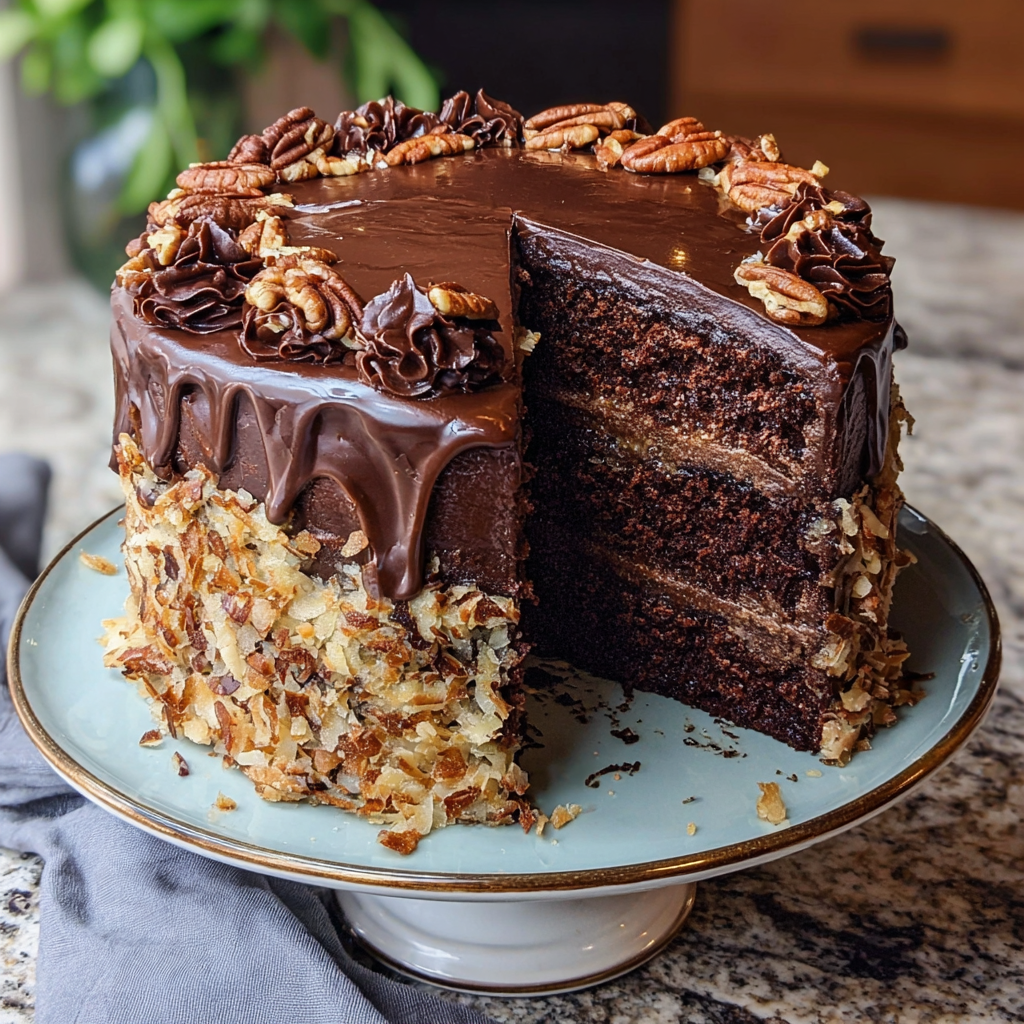
Pro Tips for German Chocolate Cake Success
Achieving consistently excellent German chocolate cake results requires mastering several professional techniques. Moreover, these insider secrets elevate home baking to bakery-quality standards.
Temperature Control Mastery
Room temperature ingredients blend more easily and create smoother batters. Additionally, cold eggs and buttermilk can cause butter to seize or create lumps. Furthermore, plan ahead by removing dairy and eggs from refrigeration 30 minutes before baking.
Similarly, oven temperature accuracy significantly affects baking results. Moreover, invest in an oven thermometer to verify actual temperatures. Therefore, adjust settings as needed to maintain consistent 350°F throughout baking.
Mixing Technique Secrets
Cream butter and sugar until genuinely light and fluffy, not just combined. Additionally, proper creaming incorporates air for tender texture. Furthermore, scrape bowl sides frequently to ensure even mixing throughout.
When adding dry ingredients, mix only until just combined to prevent tough layers. Moreover, overmixing develops gluten, creating dense, chewy texture. Therefore, stop mixing immediately when flour disappears into the batter.
Frosting Consistency Guidelines
Cook the coconut-pecan frosting until it reaches proper thickness for spreading. Additionally, it should hold its shape when dropped from a spoon. However, if too thick, thin with additional evaporated milk gradually.
Furthermore, completely cooled frosting spreads more easily and adheres better. Specifically, warm frosting can melt or slide off cake layers. Therefore, allow adequate cooling time for optimal assembly results.
Common Mistakes to Avoid with German Chocolate Cake
Even experienced bakers can encounter challenges when making German chocolate cake. Moreover, understanding these common pitfalls helps ensure success on your first attempt.
Batter Preparation Errors
Overmixing the batter develops gluten, resulting in tough, dense cake layers. Additionally, fold ingredients gently just until combined for tender results. Furthermore, lumpy batter indicates inadequate sifting of dry ingredients initially.
Similarly, incorrect ingredient temperatures affect proper mixing and final texture. Moreover, cold ingredients don’t blend smoothly with room temperature butter. Therefore, plan timing to allow proper temperature adjustment.
Baking Temperature Problems
Oven temperatures that run hot create burnt exteriors with undercooked centers. Additionally, temperatures too low result in flat, dense layers that don’t rise properly. Furthermore, uneven temperatures cause lopsided or cracked cake layers.
Moreover, opening oven doors frequently during baking causes temperature fluctuations. Specifically, this can result in sunken centers or uneven rising. Therefore, resist checking progress until minimum baking time passes.
Frosting Technique Issues
Cooking frosting at excessive heat causes curdling or separation. Additionally, insufficient cooking creates runny consistency that won’t hold shape. Furthermore, adding coconut and pecans while mixture is too hot can affect texture negatively.
Similarly, attempting to frost warm cake layers causes melting and sliding. Moreover, rushed cooling doesn’t allow proper flavor development in the cooked frosting. Therefore, patience during both cooling phases ensures optimal results.
Variations and Customizations for German Chocolate Cake
This versatile German chocolate cake recipe adapts beautifully to various preferences and dietary needs. Additionally, simple modifications create exciting new flavor combinations while maintaining the classic foundation.
Frosting Flavor Variations
Traditional coconut-pecan frosting can be enhanced with additional extracts. Moreover, almond extract complements the coconut flavors beautifully. Additionally, rum extract adds sophisticated depth that appeals to adult palates.
Furthermore, toast the coconut and pecans before incorporating for enhanced nutty flavors. Specifically, light browning intensifies taste without overwhelming the base frosting. However, cool completely before adding to prevent melting the butter base.
Cake Layer Modifications
Coffee enhances chocolate flavors without adding distinct coffee taste. Additionally, substitute strong cooled coffee for the hot water in the recipe. Furthermore, this technique deepens the chocolate notes significantly.
Similarly, adding a tablespoon of espresso powder intensifies chocolate flavors dramatically. Moreover, this professional baker’s trick creates more complex taste profiles. Therefore, adjust according to personal preference for chocolate intensity.
Dietary Adaptation Options
Gluten-free versions work well using cup-for-cup flour substitutes. Additionally, ensure all other ingredients are certified gluten-free for celiac safety. Furthermore, the dense, moist texture adapts well to alternative flours.
Moreover, dairy-free adaptations can substitute plant-based alternatives successfully. Specifically, use vegan butter and plant milk in both cake and frosting. However, results may vary slightly in texture and flavor intensity.
Serving Suggestions and Presentation Ideas
Perfectly crafted German chocolate cake deserves equally thoughtful presentation and serving. Moreover, proper plating and accompaniments enhance the overall dining experience significantly.
Classic Presentation Methods
Serve generous slices on dessert plates with clean edges for elegant appearance. Additionally, garnish with additional toasted coconut and pecan halves for visual appeal. Furthermore, a light dusting of cocoa powder adds professional finishing touches.
Similarly, fresh berries provide color contrast and palate-cleansing acidity. Moreover, strawberries or raspberries complement the rich chocolate and coconut flavors. Therefore, arrange artfully alongside each slice for restaurant-quality presentation.
Creative Serving Ideas
Transform leftover cake into decadent trifle layers with whipped cream. Additionally, crumble cake pieces between frosting and cream layers in glass bowls. Furthermore, this presentation showcases all components while creating new textural experiences.
Moreover, individual cupcake versions work beautifully for parties and events. Specifically, divide batter among lined muffin cups and adjust baking time accordingly. Subsequently, top each with a dollop of coconut-pecan frosting for perfect portion control.
Beverage Pairing Recommendations
Rich coffee complements the chocolate flavors while cutting through frosting richness. Additionally, cold milk provides classic comfort pairing that appeals to all ages. Furthermore, dessert wines like port enhance the cake’s sophisticated flavor profile.
Similarly, bourbon or whiskey creates adult-oriented pairing for special occasions. Moreover, the spirit’s caramel notes harmonize beautifully with coconut and pecan elements. Therefore, consider audience preferences when selecting accompanying beverages.
Storage and Freshness Tips
Proper storage techniques maintain your German chocolate cake’s quality and flavor for maximum enjoyment. Additionally, understanding preservation methods extends the dessert’s lifespan while preserving taste and texture.
Short-Term Storage Solutions
Store assembled cake covered at room temperature for up to three days. Moreover, use a cake dome or tent loosely with plastic wrap to prevent drying. Additionally, avoid refrigeration unless absolutely necessary, as it can dry the cake layers.
Furthermore, cut slices cleanly with a sharp, warm knife for best presentation. Specifically, wipe the blade between cuts to prevent frosting buildup. Therefore, each slice maintains clean edges and attractive appearance.
Long-Term Preservation Methods
Freeze unfrosted cake layers individually wrapped in plastic for up to three months. Additionally, thaw completely before frosting for best texture results. Furthermore, this approach allows fresh frosting preparation when ready to serve.
Moreover, assembled cake can be frozen for special occasion planning. Specifically, freeze uncovered until firm, then wrap carefully in plastic and foil. However, expect slight texture changes after freezing and thawing.
Maintaining Optimal Quality
Keep cake away from strong odors that can affect delicate flavors. Additionally, store in cool, dry locations away from direct sunlight or heat sources. Furthermore, high humidity can affect frosting consistency and cake texture.
Similarly, serve at room temperature for optimal flavor and texture experience. Moreover, cold cake mutes flavors and creates firmer, less pleasant mouthfeel. Therefore, allow refrigerated cake to return to room temperature before serving.
Nutritional Information and Health Considerations
Understanding the nutritional aspects of German chocolate cake helps make informed dietary decisions. Moreover, this rich dessert provides energy and satisfaction while being an occasional indulgence.
Caloric and Macronutrient Content
Each generous slice contains approximately 450-500 calories from combined cake and frosting. Additionally, the macronutrient profile includes carbohydrates from flour and sugar, fats from butter and nuts, and protein from eggs and milk. Furthermore, the coconut and pecans contribute healthy fats and fiber.
Moreover, the cake provides some essential nutrients including calcium from dairy ingredients. Specifically, eggs contribute high-quality protein and various vitamins. However, this dessert should be enjoyed as part of a balanced diet rather than daily consumption.
Portion Control Strategies
Cut smaller slices to reduce caloric intake while still enjoying the full flavor experience. Additionally, serve with fresh fruit to add volume and nutrients to the dessert course. Furthermore, sharing slices allows tasting without excessive consumption.
Similarly, reserve this rich dessert for special occasions rather than regular treats. Moreover, the effort required for preparation naturally limits frequency of consumption. Therefore, view it as a celebration food rather than everyday indulgence.
Troubleshooting German Chocolate Cake Problems
Even careful preparation can encounter challenges when making German chocolate cake. Moreover, identifying solutions quickly helps salvage efforts and improve future attempts.
Cake Layer Issues
Dense, heavy layers often result from overmixing or incorrect ingredient temperatures. Additionally, ensure proper creaming of butter and sugar for adequate air incorporation. Furthermore, measure flour accurately, as too much creates heavy texture.
Conversely, layers that collapse or sink indicate insufficient structure or too much liquid. Moreover, check leavening agent freshness, as expired products won’t provide proper lift. Subsequently, verify oven temperature accuracy for consistent baking results.
Frosting Consistency Problems
Runny frosting suggests insufficient cooking time or temperature. Additionally, continue cooking while stirring until proper thickness develops. Furthermore, cooling completely helps achieve spreading consistency naturally.
Meanwhile, overly thick frosting can be thinned with additional evaporated milk gradually. Moreover, reheat gently if the mixture becomes too stiff during cooling. Therefore, adjust consistency carefully to achieve optimal spreading properties.
Assembly Challenges
Cake layers that crack during handling indicate insufficient cooling time. Additionally, completely cool layers are more stable and less likely to break. Furthermore, use offset spatulas for easier frosting application and smoother results.
Similarly, frosting that slides off layers suggests temperature issues or improper consistency. Moreover, ensure both cake and frosting are at room temperature during assembly. Therefore, patience during preparation prevents frustrating assembly failures.
Advanced Techniques for German Chocolate Cake Mastery
Professional baking techniques elevate your German chocolate cake from good to extraordinary. Moreover, these advanced methods create bakery-quality results that impress even experienced bakers.
Professional Layering Methods
Level cake layers with a serrated knife for even assembly and professional appearance. Additionally, brush layers lightly with simple syrup for enhanced moisture and flavor. Furthermore, this technique prevents dry edges while adding subtle sweetness.
Moreover, apply thin crumb coats before final frosting for smoother finishes. Specifically, seal loose crumbs with minimal frosting, then chill briefly before final application. Therefore, this extra step creates flawless final presentation.
Flavor Enhancement Strategies
Bloom cocoa powder in hot liquid before incorporating for intensified chocolate flavor. Additionally, this technique releases maximum flavor compounds for richer taste. Furthermore, cool completely before adding to prevent affecting batter temperature.
Similarly, brown butter before incorporating for enhanced nutty notes. Moreover, the caramelized milk solids add complexity that complements coconut and pecan flavors. However, cool to room temperature before use to prevent melting other ingredients.
Decoration and Finishing Touches
Pipe decorative borders using remaining frosting for professional presentation. Additionally, use star tips to create rosettes or shells around cake edges. Furthermore, these details elevate visual appeal significantly with minimal extra effort.
Moreover, create chocolate shavings or curls for elegant garnishing options. Specifically, use vegetable peelers on room temperature chocolate bars for best results. Therefore, these finishing touches transform homemade cakes into bakery-worthy presentations.
FAQs About German Chocolate Cake
Understanding common questions about German chocolate cake helps ensure successful results. Moreover, these answers address frequent concerns and provide helpful guidance for home bakers.
Q: Can I make this cake ahead of time?
A: Yes, you can bake layers up to two days ahead and store covered at room temperature. Additionally, the frosting can be made one day ahead and refrigerated. However, assemble the cake day of serving for best texture and appearance.
Q: Why is my frosting not thickening properly?
A: The frosting needs adequate cooking time to reach proper consistency. Moreover, continue cooking while stirring constantly until it coats the back of a spoon. Additionally, cooling helps achieve final thickness, so be patient during this process.
Q: Can I substitute the buttermilk in this recipe?
A: While buttermilk provides optimal results, you can make a substitute using regular milk plus acid. Specifically, add one tablespoon of lemon juice or vinegar to one cup of milk. However, let it sit for 5 minutes before using to develop proper acidity.
Q: How do I prevent my cake layers from sticking to the pans?
A: Properly grease pans with butter or cooking spray, then dust with flour or cocoa powder. Additionally, line pan bottoms with parchment paper for extra insurance. Furthermore, cool layers exactly 10 minutes before removing from pans.
Q: Can I freeze this cake?
A: Yes, unfrosted layers freeze excellently for up to three months when properly wrapped. Additionally, assembled cake can be frozen, though texture may change slightly. However, thaw completely at room temperature before serving for best results.
Q: What’s the difference between German chocolate and regular chocolate cake?
A: German chocolate cake specifically uses the coconut-pecan frosting as its signature element. Moreover, the cake itself is typically milder in chocolate flavor to complement the rich frosting. Additionally, the three-layer construction is traditional for proper frosting distribution.
Historical Background of German Chocolate Cake
Understanding the origins of German chocolate cake adds appreciation for this beloved American dessert. Moreover, the fascinating history reveals how marketing and naming conventions created lasting culinary traditions.
The Samuel German Connection
Contrary to popular belief, this cake didn’t originate in Germany. Additionally, it was named after Samuel German, who developed a type of dark baking chocolate for Baker’s Chocolate Company in 1852. Furthermore, his chocolate became known as “Baker’s German’s Sweet Chocolate.”
Moreover, the original recipe appeared in a Dallas newspaper in 1957, submitted by Mrs. George Clay. Specifically, she created the recipe using German’s sweet chocolate, which gave the cake its distinctive name. Therefore, this American creation became a classic through creative marketing and exceptional taste.
Evolution of the Recipe
The original recipe has remained largely unchanged since its 1957 debut. Additionally, this consistency speaks to the perfection of the original formula. Furthermore, regional variations exist, but the core elements remain constant across generations.
Similarly, the cake gained popularity through word-of-mouth and cookbook publications. Moreover, its impressive appearance and unique flavor profile made it a favorite for special occasions. Therefore, this dessert earned its place in American baking tradition through proven excellence.
Conclusion
This comprehensive guide to German chocolate cake provides everything needed for baking success. Moreover, the combination of detailed instructions, professional tips, and troubleshooting advice ensures exceptional results for bakers of all skill levels.
Furthermore, remember that baking is both science and art requiring practice and patience. Additionally, don’t be discouraged if your first attempt isn’t perfect – even professional bakers continue learning. However, following these detailed guidelines significantly improves your chances of immediate success.

